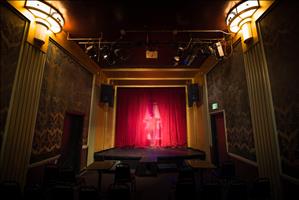On the summer evening of Monday, August 29, 1932, Film Row in Seattle's Belltown neighborhood is all abuzz as another private screening room on the strip holds a grand-opening event. Benjamin F. Shearer (ca. 1890-1972) opens the Jewel Box in the middle of the building at 2318 2nd Avenue that also houses his thriving theatrical-supply company. Film Row is the name commonly used since the 1920s to describe a stretch of 2nd Avenue in Belltown where a couple dozen of Hollywood's top film studios -- including RKO, MGM, Warner Brothers, and United Artists -- built film exchanges. These outposts typically house vaults for film storage, poster libraries -- and tiny theaters where movie-theater owners from Washington, Idaho, Montana, and Alaska can visit and view forthcoming films to decide whether to book them for their venues.
Shearer Building on Film Row
Film Row was centered in the 2300 block of 2nd Avenue, where the Lorraine Hotel at 2327 2nd Avenue catered to visiting movie moguls and movie stars, and just across the street the Rendezvous Cafe at 2320 2nd Avenue catered to their culinary needs, while a basement speakeasy there reputedly satisfied their Prohibition Era tastes for alcoholic libations.
The Rendezvous was operated by George Blair, who leased his storefront space in the B. F. Shearer Building. Built in 1925, the building housed the factory and offices of B. F. Shearer's eponymous company -- an extremely successful theatrical-supply firm that had outfitted many of Seattle's top venues with curtains, seating, lighting, and projection booths since Shearer and his brother founded it in 1926. The B. F. Shearer Company's factory employed scores of skilled workers who painted stage backdrops, sewed curtains, upholstered theater chairs, built light fixtures, and otherwise outfitted theatrical spaces.
Shearer also provided the service of designing complete interior schemes for both new and old theaters. It was likely that facet of the business that inspired him to create his own small theater, the Jewel Box, in the middle of his building at 2318 2nd Avenue. Here film companies could show off their films for theater owners, and Shearer could likewise show off the splendid interior design of the Jewel Box as an example of the quality work he offered.
A Real Gem
And the Jewel Box was a real gem. Designed by noted local architect Bjorn Moe, the Art Deco-detailed room boasted a separate entrance lobby, cozy seating, and direct access to the adjacent Rendezvous Cafe -- not to mention that beckoning speakeasy below.
On the day following the August 29 grand opening, The Seattle Times had a bit of fun teasing the general public with its coverage -- this at a time, remember, when the Great Depression was in full swing and people were struggling financially. The newspaper headlined its article: "No Admission Is Charged at New Theatre -- But the Jewel Box, Built by B. F. Shearer, Is for Exhibitors Only" (Hays).
While townsfolk were scraping together their pennies and deciding if they could afford to attend various other films showing downtown -- including Horse Feathers with the Marx Brothers at the Fox Theatre), Sky Devils with Spencer Tracy at the Capitol Theatre, and Blondie of the Follies with Robert Montgomery and Marion Davies at the 5th Avenue Theatre -- a privately invited VIP crowd graced the Jewel Box gala. Screened that evening were three new selections distributed by United Artists: Mr. Robinson Crusoe with Douglas Fairbanks Sr., which had just been released on August 19; a Mickey Mouse comedy; and Walt Disney's historically significant Flowers and Trees, which was the first-ever cartoon produced in Technicolor and which went on to win the inaugural Academy Award for Best Animated Short.
Despite this cartooning innovation, Seattle Times theater beat writer Richard E. Hays was most impressed by the venue itself:
"But as good as the screen entertainment proved, it was second in admiration and interest compared to the Jewel Box.
"This new theatre seats seventy guests. It is decorated in blue and gold, richly carpeted and furnished with comfortable and luxurious seats. From the most improved sound equipment to the last word in ventilation system, it is a completely equipped theatre. It even has a small foyer, thickly carpeted and furnished in modernistic mode in blue and gold" (Hays).
As of 2017 the B. F. Shearer Building survived as one the few remaining structures that played key roles in the emergence and vibrancy of Seattle's long-gone Film Row. And within that storied building, the Rendezvous Cafe continued to serve food and drink along with a distinct spirit of faded glamour, while the adjacent Jewelbox Theater (as its name was now written) remained as the only extant Film Row screening room -- offering up a diverse array of musical and comedic performances in addition to serving the community as a rentable private event space.

